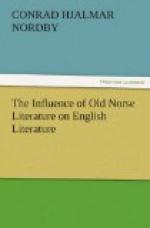JAMES RUSSELL LOWELL (1819-1891).
The Story of the Norse Kings, thus translated by an Englishman, suggested to our American poet, Longfellow, a series of lyrics on King Olaf. The young college professor that wrote about Frithjof’s Saga in the North American Review for 1837, was bound, sooner or later, to come back to the field when he found that the American reading public would listen to whatever songs he sang to them. Before 1850, Longfellow had written “The Challenge of Thor,” a poem which imitated the form of Icelandic verse and catches much of its spirit. In 1859, the thought came to him “that a very good poem might be written on the Saga of King Olaf, who converted the North to Christianity.” Two years later he completed the lyrics that compose “The Musician’s Tale” in The Tales of a Wayside Inn, published in 1863, and in this work “The Challenge of Thor” serves as a prelude. The pieces after this prelude are not imitations of the Icelandic verse, but are like Tegner’s Frithjof’s Saga, in that each new portion has a meter of its own. There is not, either, a consistent effort to put the flavor of the North into the poetry, so that, properly speaking, we have here only the retelling of an old tale. The ballad fervor and movement are often perceptible, though nowhere does the poet strike the ringing note of “The Skeleton in Armor,” published in the volume of 1841.
Truth to tell, Longfellow’s “Saga of King Olaf” is not a remarkable work. One who reads the few chapters in Carlyle’s Early Kings of Norway that deal with Olaf Tryggvason gets more of the fire and spirit of the old saga at every turning. The poet chooses scenes and incidents very skilfully, but for their proper presentation a terseness is necessary that is not reconcilable with frequent rhymes. Compare the saga account with the poem’s: “What is this that has broken?” asked King Olaf. “Norway from thy hand, King,” answered Tamberskelver.
“What was that?”
said Olaf, standing
On the quarter
deck.
“Something heard I like
the stranding
Of a shattered
wreck.”
Einar then, the arrow taking
From the loosened
string,
Answered, “That was
Norway breaking
From thy hand,
O King!”
Nevertheless, Longfellow is to be thanked for acquainting a wide circle of readers with the sterling saga literature.
One other American poet was busy with the ancient Northern literature at this time. James Russell Lowell wrote one notable poem that is Old Norse in subject and spirit, “The Voyage to Vinland.” The third part of the poem, “Gudrida’s Prophecy,” hints at Icelandic versification, and the short lines are hammer-strokes that warm the reader to enthusiasm. Far more of the spirit of the old literature is in this short poem than is to be found in the whole of Longfellow’s “Saga of King Olaf.” The character of Bioern is well drawn, recalling Bodli, of Morris’ poem, in its principal features. Certainly there is a reflection here of that Old Norse conception of life which gave to men’s deeds their due reward, and which exalted the power of will. This poem was begun in 1850, but was not published till 1868.




